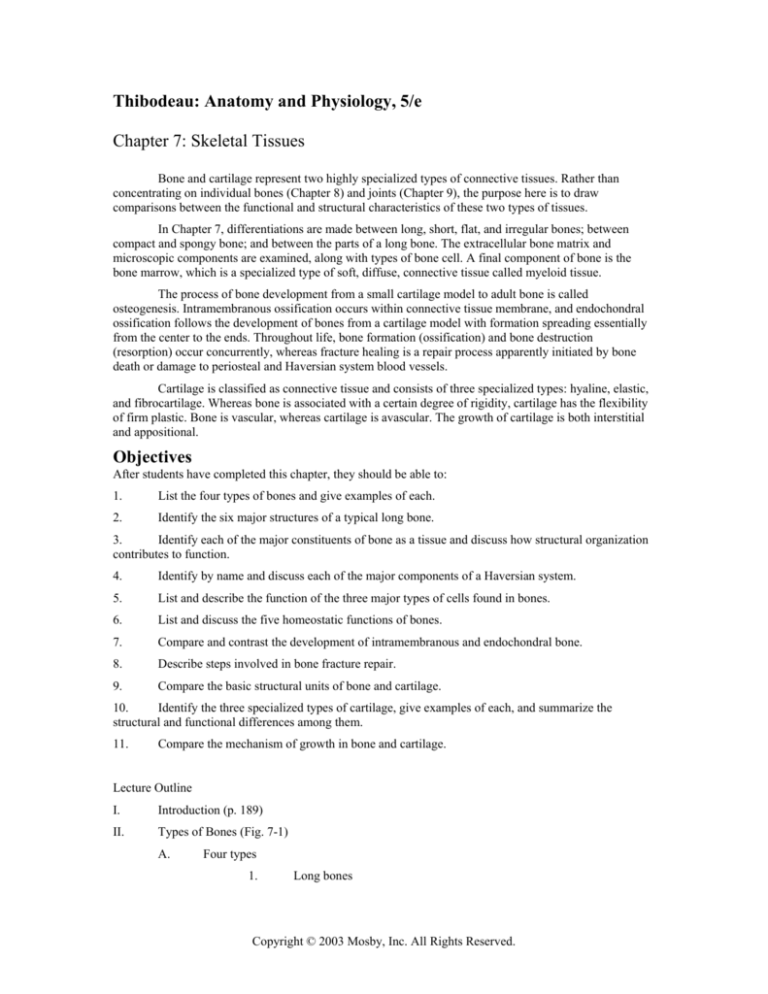
Thibodeau: Anatomy and Physiology, 5/e
Chapter 7: Skeletal Tissues
Bone and cartilage represent two highly specialized types of connective tissues. Rather than
concentrating on individual bones (Chapter 8) and joints (Chapter 9), the purpose here is to draw
comparisons between the functional and structural characteristics of these two types of tissues.
In Chapter 7, differentiations are made between long, short, flat, and irregular bones; between
compact and spongy bone; and between the parts of a long bone. The extracellular bone matrix and
microscopic components are examined, along with types of bone cell. A final component of bone is the
bone marrow, which is a specialized type of soft, diffuse, connective tissue called myeloid tissue.
The process of bone development from a small cartilage model to adult bone is called
osteogenesis. Intramembranous ossification occurs within connective tissue membrane, and endochondral
ossification follows the development of bones from a cartilage model with formation spreading essentially
from the center to the ends. Throughout life, bone formation (ossification) and bone destruction
(resorption) occur concurrently, whereas fracture healing is a repair process apparently initiated by bone
death or damage to periosteal and Haversian system blood vessels.
Cartilage is classified as connective tissue and consists of three specialized types: hyaline, elastic,
and fibrocartilage. Whereas bone is associated with a certain degree of rigidity, cartilage has the flexibility
of firm plastic. Bone is vascular, whereas cartilage is avascular. The growth of cartilage is both interstitial
and appositional.
Objectives
After students have completed this chapter, they should be able to:
1.
List the four types of bones and give examples of each.
2.
Identify the six major structures of a typical long bone.
3.
Identify each of the major constituents of bone as a tissue and discuss how structural organization
contributes to function.
4.
Identify by name and discuss each of the major components of a Haversian system.
5.
List and describe the function of the three major types of cells found in bones.
6.
List and discuss the five homeostatic functions of bones.
7.
Compare and contrast the development of intramembranous and endochondral bone.
8.
Describe steps involved in bone fracture repair.
9.
Compare the basic structural units of bone and cartilage.
10.
Identify the three specialized types of cartilage, give examples of each, and summarize the
structural and functional differences among them.
11.
Compare the mechanism of growth in bone and cartilage.
Lecture Outline
I.
Introduction (p. 189)
II.
Types of Bones (Fig. 7-1)
A.
Four types
1.
Long bones
Copyright © 2003 Mosby, Inc. All Rights Reserved.
Chapter 7: Skeletal Tissues
B.
III.
IV.
2.
Short bones
3.
Flat bones
4.
Irregular bones
Parts of a long bone (Fig. 7-2)
1.
Diaphysis
2.
Epiphyses
3.
Articular cartilage
4.
Periosteum
5.
Medullary cavity
6.
Endosteum
Bone Tissue (p. 190)
A.
Bone cells
B.
Composition of bone matrix
1.
Inorganic salts
2.
Measuring bone mineral density
3.
Organic matrix
Microscopic Structure of Bone (Chapter 5)
A.
Compact bone (Fig. 7-3)
1.
2.
B.
C.
V.
VI.
2
Osteon
a.
Lamellae
b.
Lacunae
c.
Canaliculi
d.
Haversian canal (central canal)
Perforating canal (Volkmann canals)
Cancellous bone (Figs. 7-3, A–C; 7-4)
1.
Spicules
2.
Trabeculae
Types of bone cells (p. 195)
1.
Osteoblasts
2.
Osteoclasts (Fig. 7-5)
3.
Osteocytes (Fig. 7-6)
Bone Marrow (p. 195)
A.
Myeloid tissue
B.
Red marrow
C.
Yellow marrow
Functions of Bone (p. 196)
A.
Support
Copyright © 2003 Mosby, Inc. All Rights Reserved.
Chapter 7: Skeletal Tissues
VII.
B.
Protection
C.
Movement
D.
Mineral storage
E.
Hematopoiesis
Regulation of Blood Calcium Levels (p. 196)
A.
VIII.
3
Mechanisms of calcium homeostasis
1.
Parathyroid hormone
2.
Calcitonin
Development of Bone (Fig. 7-7)
A.
Intramembranous ossification
B.
Endochondral ossification (Figs. 7-8, 7-9, 7-10)
IX.
Bone Growth and Resorption (Figs. 7-11, 7-12)
X.
Repair of Bone Fractures (Fig. 7-13)
A.
XI.
1.
Formation of fracture hematoma
2.
Formation of callus
3.
Bone remodeling (Fig. 7-11)
Cartilage (p. 202)
A.
XII.
Stages of repair
Types of cartilage
1.
Hyaline cartilage (Fig. 7-14, A)
2.
Elastic cartilage (Fig. 7-14, B)
3.
Fibrocartilage (Fig. 7-14, C)
B.
Histophysiology of cartilage
C.
Growth of cartilage
1.
Interstitial growth
2.
Appositional growth
The Big Picture
A.
B.
Characteristics of the tissue
1.
Cells produce solid or semisolid matrix
2.
Cells in bone continually build and destroy the matrix
Effect of tissue characteristics on the body
1.
Body part protection
2.
Support of body parts
3.
Positioning of body parts
4.
Shape of body parts
5.
Position of the entire body
6.
Homeostatic functions:
Copyright © 2003 Mosby, Inc. All Rights Reserved.
Chapter 7: Skeletal Tissues
4
a.
Mineral storage and release
b.
Blood cell production
1)
Control of pH
2)
Control gas exchange
3)
Control nutrient transport
XIII.
Cycle of Life: Skeletal Tissues (p. 204)
XIV.
Mechanisms of Disease: Diseases of Skeletal Tissues (p. 204)
A.
B.
Neoplasms
1.
Osteochondroma
2.
Osteosarcoma
3.
Chondrosarcoma
Metabolic bone diseases
1.
Osteoporosis
2.
Osteomalacia
3.
Paget's disease (osteitis deformans)
4.
Osteomyelitis
Copyright © 2003 Mosby, Inc. All Rights Reserved.








